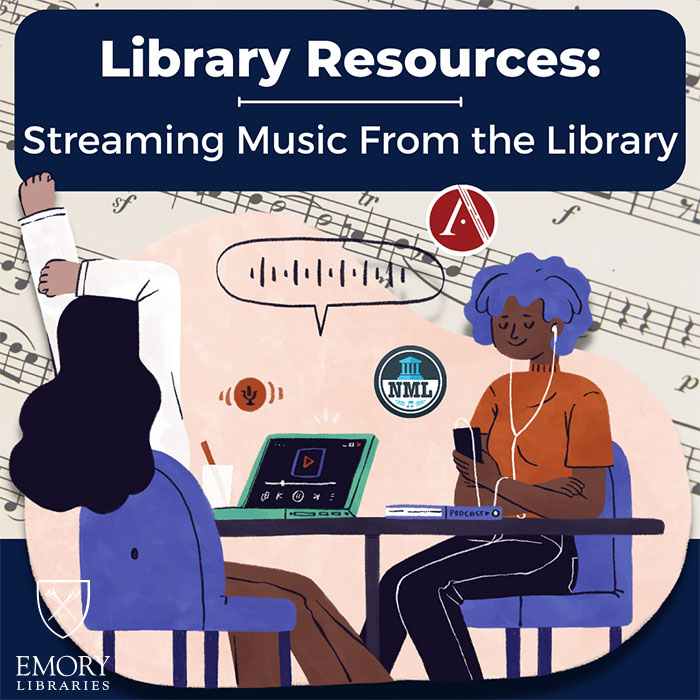Did you know that you can stream music through the Emory Libraries for free? At Emory, we have two main platforms for streaming music: Naxos Music Library and Alexander Street Press. These resources are great tools for practicing musicians, researchers, and anyone who enjoys music. In this post, I’ll talk a little bit about each database and discuss their benefits.
Naxos Musical Library (NML)
Naxos has a lot of content split between a few different platforms. There are three music libraries for Naxos: Classical music, World music, and Jazz.
Naxos also has a “Naxos: Video Library” for performances and “Naxos: Spoken Word Library” for public domain audiobooks in four different languages. The Naxos app is great for streaming pieces offline! Create a playlist and download the pieces for listening on-the-go. However, if you plan on doing more complicated searches and reading liner notes, I recommend using the desktop version.
How To Use Naxos
Naxos is a little tricky to use, but once you get the hang of it, it is an invaluable resource. You must access Naxos through the Emory Libraries page (libraries.emory.edu). From there, go to databases and search for Naxos. You can choose between Naxos (classical) Music, Video, World, Jazz, and Spoken Word. For more information about how to create a Naxos account and use Naxos, check out our Classical Music Research Guide.
Alexander Street Press Music Online: Listening (ASP)
Alexander Street Press has a lot of content, but for the sake of music listening, look at Alexander Street Press Music Online: Listening (a.k.a. Music and Performing Arts). They have a wide variety of jazz, classical music, independent popular music, contemporary world music, opera, and the Smithsonian Global Sound collection. In addition to millions of tracks, ASP has many video recordings related to music research and performance.
What are the Benefits of Streaming Through the Library?
Why stream through the library when there’s YouTube? The biggest benefit to using Naxos or ASP over other streaming services is metadata. In essence, metadata provides the context: the who, what, where, why, and when that helps you to discover and interact with information. For music and videos, the metadata includes information about the composer(s), performer(s), dates composed and published, piece duration, and record label. This information will make it much easier for users to cite their sources and to find relevant information.
These databases also have more reliable information than YouTube. Many YouTube videos lack descriptions, but Naxos has other written resources and background information for many songs/pieces on the database. ASP albums often include documents and liner notes (the little booklets that come inside of albums or CDs to explain the recording).
Last, but certainly not least: there are no ads on either of these databases! All information is free to use through your Emory account.
Can’t Find What You’re Looking For?
Not everything is available for streaming through the library or Spotify. For those hard-to-find tracks, the library also has a large collection of CDs and LPs available; you can also check out equipment to play them.
–Damaris Billups (she/her) is a senior music major at Agnes Scott College who is currently interning in the Music and Media Library for Fall 2022. In school, she is a violist, an active student leader on campus, and works as lead student assistant in the Music Department. Damaris will graduate in December 2022, and she plans to pursue graduate degrees in ethnomusicology and library science. Outside of her academic interests, she is also a huge fan of Star Trek.



